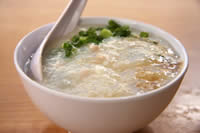 Congee is a thin porridge or gruel most often made from rice. Congees strengthen the Spleen energy and nourish Blood. Congee is very commonly eaten for breakfast in China. Because of the nourishing properties of congee, and the fact that it is very easily digested, congees are often prescribed for elderly or chronically ill patients with weak blood and low energy. Congee made with brown rice is often given to nursing mothers to increase milk supply. The therapeutic properties of congee may be enhanced by adding traditional chinese herbs or other nutritional foods with properties known to address specific health issues.
Congee is a thin porridge or gruel most often made from rice. Congees strengthen the Spleen energy and nourish Blood. Congee is very commonly eaten for breakfast in China. Because of the nourishing properties of congee, and the fact that it is very easily digested, congees are often prescribed for elderly or chronically ill patients with weak blood and low energy. Congee made with brown rice is often given to nursing mothers to increase milk supply. The therapeutic properties of congee may be enhanced by adding traditional chinese herbs or other nutritional foods with properties known to address specific health issues.
To make a rice congee, use at least six times the amount of water as you do rice and simmer covered for at least one hour. One cup of rice usually makes two or three servings. Crockpots are great to prepare congee. Set the crockpot on low and leave for at least four to six hours. It is better to use too much water than too little. The longer the congee cooks, the more powerful the nutritional benefit.
Chinese herbs or other foods may be added to the congee. For example, aduki beans in chinese medicine are a diuretic and may be helpful to treat edema and gout. Carrots added to the congee may eliminate flatulence.
Here is a sweet congee recipe that may even be eaten for dessert.
Wolfberry Fruit Congee Ingredients:
- ½ cup wolfberry fruits (gou qi zi)
- ½ cup rice
- 1 ½ tablespoons raw sugar
- 5 cups of water
Directions:
Wash the wolfberry fruits and rice. Add them to a soup pot with the water. Cover and bring to a boil. Reduce heat and simmer for at least one hour, until the fluid becomes very thick. Add in the sugar. Mix and serve. This recipe makes one serving.
This recipe and many other sweet congee recipes may be found in “Unleashing the Power of Food, Recipes to Heal By.”
Wolfberry fruits, also known as lycium or gou qi zi in Chinese medicine, look like red raisins and are considered an herb in traditional chinese medicine that nourishes the Kidneys and Liver. Gou qi zi replenishes blood, nourishes the yin and is often used for vision problems related to deficiency of the Kidney and Liver yin. Gou qi zi can often be found in Asian grocery stores or health food stores. If you have trouble finding gou qi zi, your local acupuncturist should be able to order some for you from a reputable herbal supply company.
About the Author: Joyce Marley is a licensed acupuncturist who provides acupuncture therapy in New Hartford, NY. She writes Traditional Chinese Medicine (TCM) health articles about acupuncture and Chinese herbal medicine.



